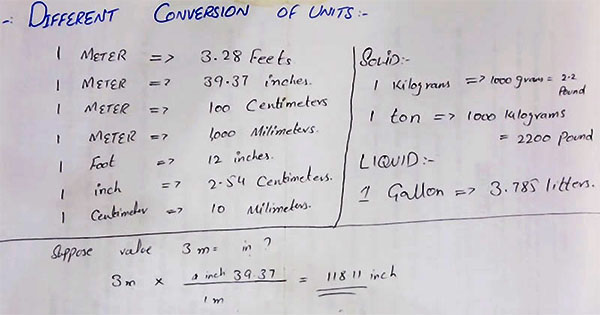Learn different conversion factors in civil engineering construction

Magnitudes of measurements are usually provided with regard to a definite unit. In surveying, the most frequently applied units describe quantities of length (or distance), area, volume, and horizontal or vertical angles. The two systems utilized for indicating units of measure belong to the English and metric systems. Units in the English system stand for historical units of measurement. The metric system refers to a decimalized system of measurement. As the metric system is globally recognized, it is called as the International System of Units and shortened as SI.
The elementary units for length or distance measurements in the English system belong to the inch, foot, yard, and mile. Other units of length also comprise of the rod, furlong, and chain.
The elementary unit of length in the SI system refers to the meter. The meter was originally projected to be one ten-millionth of the distance from the Equator to the North Pole (at sea level).
There exist two diverse conversions associated with the foot and the meter. In 1893, the United States officially described a meter as 39.37 inches. Under this standard, the foot was equivalent to 12/39.37 m (approximately 0.3048 m). In 1959, a new standard was chosen that described an inch equivalent to 2.54 cm. Under this standard, the foot was equivalent to accurately 0.3048 m. The older standard is now mentioned as the U.S. survey foot, whereas the new standard is mentioned as the international foot.
In this exclusive construction video tutorial, you will learn the various conversion units (IS units) which are extensively utilized in the job site.
For a square you should locate the length of one of the sides (as each side contains the equivalent length) and then multiply this by itself to determine the area.
Given below, the details of various conversion units:-
1 meter = 3.28 feet
1 meter = 39.37 inches
1 meter = 100 centimeter
1 meter = 1000 milimeter
1 feet = 12 inches
1 inch = 2.54 centimeters
1 centimeter = 10 milimeter
Given below, the conversion units of solids:-
1 kilogram = 1000 grams = 2.2 pound
1 ton = 1000 kilogram = 2200 pounds
Given below, the conversion units of liquids:-
1 gallon (mainly for water tank) = 3.785 liters
Now, if you want to convert the measuring unit from meter to inches, you can do it as follow:-
Assume the value as 3 meter
3 meter x 1 inch 39.37/ 1 meter (since 1 meter = 39.37 inches); it means the value to which we are converting should be provided side by side and the value from which we are converting should be provided under.
After putting the values, we get the result as 118.11 inches.
To get more detail information, go through the following video tutorial.
Video Courtesy : F&U-FORYOU

